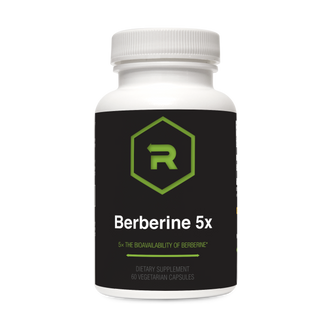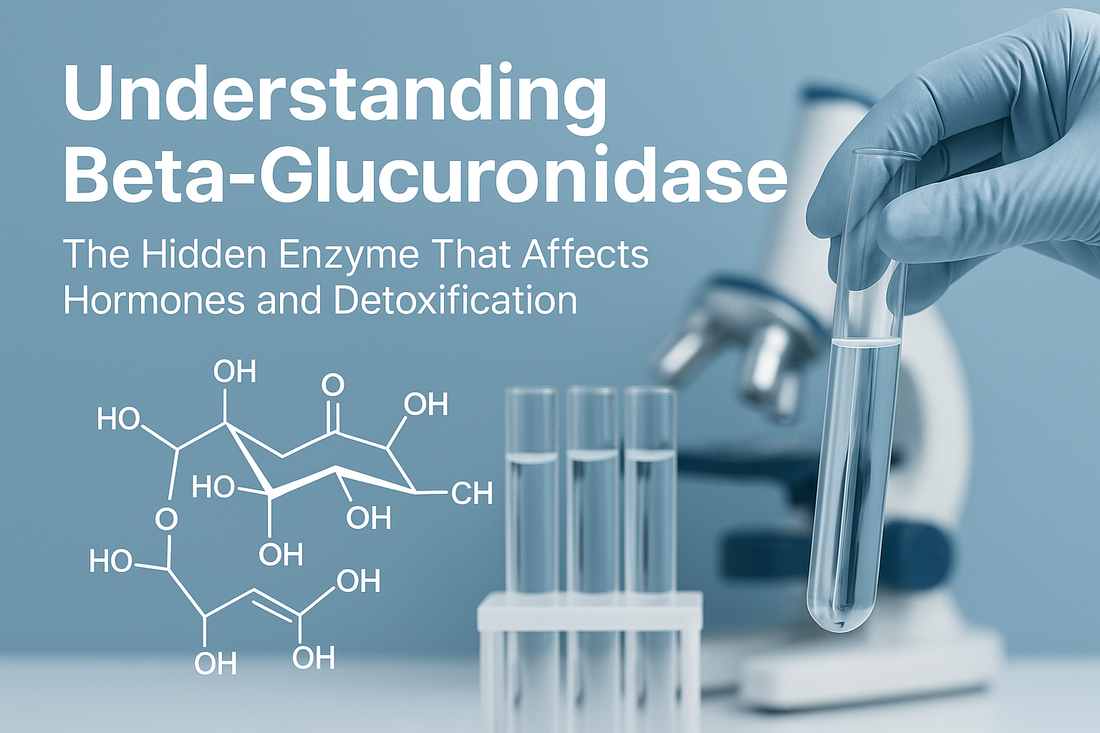Understanding Beta-Glucuronidase: The Hidden Enzyme That Affects Hormones and Detoxification
In the intricate world of human metabolism, some enzymes operate quietly in the background but exert massive influence on health and disease. Beta-glucuronidase is one of those enzymes. Though rarely discussed outside functional medicine, this enzyme plays a pivotal role in hormone metabolism, toxin elimination, and gut health. When it becomes elevated, it can undermine your detoxification pathways, recirculate toxins, and worsen conditions like estrogen dominance, autoimmune disease, and chronic inflammation.
Let’s explore what beta-glucuronidase does, why it rises, and—most importantly—how you can lower it naturally through diet, supplements, and lifestyle optimization.
What Is Beta-Glucuronidase?
Beta-glucuronidase is an enzyme primarily produced by gut bacteria, particularly in the large intestine. It also exists in the liver, kidneys, and other tissues, where it participates in the deconjugation of compounds previously tagged for elimination by a process known as glucuronidation.
Glucuronidation: The Body’s “Tag-and-Release” System
The liver’s detoxification process involves two main phases:
-
Phase I (Activation): Enzymes such as cytochrome P450 transform fat-soluble toxins, hormones, and drugs into intermediate compounds.
-
Phase II (Conjugation): The body “tags” those compounds with molecules such as glucuronic acid, making them water-soluble and ready for elimination through bile or urine.
This tagging process—glucuronidation—is crucial for clearing estrogens, bilirubin, thyroid hormones, medications, and environmental toxins.
However, beta-glucuronidase can reverse this process. It removes the glucuronic acid tag, effectively releasing the compound back into circulation. This means that substances your liver worked hard to neutralize can become reactivated and reabsorbed into your bloodstream.
Why Beta-Glucuronidase Matters
When beta-glucuronidase activity is balanced, it plays a beneficial role in recycling certain molecules and supporting gut health. But when it’s elevated, the consequences can be serious.
1. Hormone Imbalance (Estrogen Dominance)
One of the most common and well-recognized impacts of high beta-glucuronidase is estrogen recirculation. After estrogen is metabolized in the liver and conjugated with glucuronic acid, it should be eliminated through the bile and stool. But when beta-glucuronidase levels are high, the conjugated estrogen gets deconjugated—and then reabsorbed into the bloodstream.
This leads to estrogen dominance, which can manifest as:
-
PMS and mood swings
-
Breast tenderness or fibrocystic breasts
-
Weight gain, especially in hips and thighs
-
Uterine fibroids or endometriosis
-
Irregular menstrual cycles
-
Increased risk of hormone-sensitive cancers (like breast or uterine cancer)
Supporting healthy estrogen metabolism often requires both improving phase II liver detoxification and lowering beta-glucuronidase activity.
For targeted support, many functional medicine providers recommend Calcium D-Glucarate—a clinically validated compound that directly inhibits beta-glucuronidase activity and promotes the safe elimination of estrogens.
2. Impaired Detoxification and Toxin Recirculation
High beta-glucuronidase doesn’t just affect hormones—it can also cause toxin recirculation. When toxins, pesticides, heavy metals, or even pharmaceutical metabolites are reactivated by this enzyme, they re-enter systemic circulation, forcing the liver to detoxify them all over again. This adds metabolic burden and increases oxidative stress.
Symptoms of toxin recirculation may include:
-
Fatigue or brain fog
-
Skin breakouts or rashes
-
Chemical sensitivity
-
Bloating or constipation
-
Headaches or muscle aches
This is why gut health and bowel regularity are foundational to any detoxification program. Constipation, dysbiosis, and slow bile flow all contribute to higher beta-glucuronidase activity and poor clearance of waste.
3. Increased Cancer Risk
Elevated beta-glucuronidase has been linked to several cancers, particularly breast, colon, and prostate cancers, due to its ability to reactivate estrogens and carcinogens that should have been excreted. In fact, early research has identified beta-glucuronidase as a biomarker of cancer risk, especially in individuals with dysbiosis or chronic inflammation.
What Increases Beta-Glucuronidase?
Several physiological and lifestyle factors can lead to elevated beta-glucuronidase. Understanding these helps target the root cause rather than just treating symptoms.
1. Gut Dysbiosis
The most common cause of elevated beta-glucuronidase is gut dysbiosis—an imbalance in the gut microbiome. Certain bacteria, especially from the Clostridium, Escherichia (E. coli), and Bacteroides genera, produce large amounts of this enzyme.
Triggers for dysbiosis include:
-
High intake of processed foods or sugar
-
Antibiotic use
-
Low fiber diets
-
Chronic stress
-
Alcohol use
-
Environmental toxins or heavy metals
Addressing dysbiosis through a comprehensive gut restoration plan (like the 5R framework—Remove, Replace, Reinoculate, Repair, Rebalance) can help normalize beta-glucuronidase activity.
2. Constipation and Poor Bile Flow
When stool sits in the colon too long, it provides more time for bacterial enzymes (including beta-glucuronidase) to act on conjugated compounds, deconjugating estrogens and toxins. Inadequate bile flow compounds this problem because bile acids help carry conjugated toxins out of the body.
Strategies to improve bowel regularity and bile flow include:
-
Staying well-hydrated
-
Increasing dietary fiber and magnesium-rich foods
-
Taking Mag Citrate for gentle bowel support
-
Supporting bile production with bitters and taurine-rich foods
-
Ensuring daily movement and exercise
3. Hormonal Imbalance and High Estrogen Exposure
Elevated estrogen levels—whether endogenous or from xenoestrogens (environmental estrogen-like chemicals)—can upregulate beta-glucuronidase. Common sources include:
-
BPA and plastics
-
Pesticides and herbicides
-
Synthetic fragrances and cosmetics
-
Oral contraceptives or estrogen therapy
-
Excess body fat (adipose tissue releases estrogen)
To balance hormones naturally, many practitioners recommend Hormone Balance (containing DIM and other estrogen-balancing compounds) and Calcium D-Glucarate together, as they work synergistically to promote proper estrogen metabolism and clearance.
4. Liver Overload or Poor Detox Capacity
The liver is central to detoxification, and when overloaded, it can’t efficiently conjugate and excrete hormones and toxins. This backlog leads to elevated circulating estrogens and increased beta-glucuronidase activity as the gut bacteria attempt to compensate.
Supportive nutrients include:
-
Curcumin Complex – reduces inflammation and supports liver enzymes
-
Detox 2.0 – provides sulforaphane for phase II detoxification
-
Omega 1300 – supports bile flow and reduces liver inflammation
-
Cruciferous vegetables like broccoli, kale, and cauliflower
-
Garlic and onions (for sulfur compounds)
-
Adequate protein for glutathione synthesis
5. Chronic Inflammation or Infection
Beta-glucuronidase activity can also rise in the context of inflammation or infection, including in the urinary tract, liver, or intestines. Chronic infections—especially gut infections such as SIBO, Candida overgrowth, or parasitic infections—can stimulate bacterial enzyme production.
How to Lower Beta-Glucuronidase Naturally
1. Optimize Gut Microbiome Health
A balanced microbiome keeps beta-glucuronidase activity in check. Steps to achieve this include:
-
Remove pathogenic organisms and inflammatory foods (processed sugar, refined carbs, alcohol).
-
Replace digestive enzymes if low stomach acid or pancreatic insufficiency exists. Consider Complete Digestive Support.
-
Reinoculate with a broad-spectrum probiotic such as ProbioHealth 350 or MegaSporebiotic to restore beneficial bacteria.
-
Repair the intestinal lining with BPC-157 and KPV, both of which reduce inflammation and promote mucosal healing.
-
Rebalance with stress management, movement, and sleep optimization.
2. Use Calcium D-Glucarate
Calcium D-Glucarate is one of the most effective ways to inhibit beta-glucuronidase. It works by providing glucaric acid, which binds to glucuronic acid in the intestines and promotes the excretion of toxins and estrogens. It’s clinically shown to:
-
Reduce beta-glucuronidase activity
-
Lower circulating estrogen levels
-
Enhance liver detoxification capacity
-
Support cancer prevention
Typical dosing ranges from 500–1000 mg twice daily, though personalized guidance is recommended.
3. Eat a High-Fiber, Plant-Rich Diet
Fiber feeds beneficial gut bacteria and helps trap and eliminate toxins in the stool. Aim for 25–35 grams of fiber daily from:
-
Vegetables (broccoli, kale, asparagus, artichokes)
-
Flaxseed and chia seeds
-
Berries and apples (rich in pectin)
-
Legumes and oats (if tolerated)
High-fiber diets reduce beta-glucuronidase activity by shifting gut microbiome composition toward more beneficial species like Bifidobacterium and Lactobacillus.
4. Support Liver Function
The liver’s ability to conjugate toxins depends on nutrient sufficiency and reduced oxidative stress. Incorporate:
-
Cruciferous vegetables (for sulforaphane and indole-3-carbinol)
-
Curcumin Complex to combat inflammation
-
Detox 2.0 for phase II liver support
-
Omega 1300 to improve bile composition and flow
-
Adequate hydration and physical activity
5. Maintain Regular Bowel Movements
Constipation exacerbates toxin reabsorption and beta-glucuronidase activity. Daily elimination is essential. To promote regularity:
-
Consume adequate fiber and fluids
-
Supplement with Mag Citrate if stools are hard or infrequent
-
Include healthy fats (avocado, olive oil, nuts)
-
Engage in daily physical activity
6. Manage Estrogen Load
To keep estrogen metabolism efficient:
-
Avoid plastics and xenoestrogens
-
Choose organic foods when possible
-
Support metabolism with Hormone Balance
-
Ensure liver detoxification support through Calcium D-Glucarate and Curcumin Complex
7. Reduce Inflammation and Oxidative Stress
Chronic inflammation increases enzyme activity and cellular stress. Anti-inflammatory strategies include:
-
A diet rich in colorful vegetables, omega-3 fats, and polyphenols
-
Omega 1300 for inflammation modulation
-
Curcumin Complex to lower NF-kB activation
-
Regular exercise and stress reduction practices (yoga, meditation, breathwork)
Testing Beta-Glucuronidase Levels
Functional medicine stool testing, such as the Gut Zoomer, often includes a beta-glucuronidase marker. Elevated levels indicate dysbiosis, sluggish detoxification, or hormonal imbalance. Retesting after implementing gut-healing and detoxification strategies ensures progress and guides ongoing therapy.
Key Takeaways
| Factor | Effect on Beta-Glucuronidase | Strategy to Normalize |
|---|---|---|
| Gut Dysbiosis | Increases | Broad-spectrum probiotic, fiber, BPC-157 |
| Constipation | Increases | Hydration, Mag Citrate, fiber |
| High Estrogen | Increases | Hormone Balance, Calcium D-Glucarate |
| Liver Overload | Increases | Curcumin Complex, Detox 2.0, Omega 1300 |
| High Inflammation | Increases | Omega 1300, Curcumin Complex, anti-inflammatory diet |
| Healthy Microbiome | Decreases | ProbioHealth 350, high-fiber diet |
| Sulforaphane & Glucarate | Decreases | Detox 2.0, Calcium D-Glucarate |
Conclusion: Restoring Balance for Better Detox and Hormone Health
Beta-glucuronidase acts as a double-edged sword—necessary in moderation, but problematic when overactive. Elevated levels disrupt detoxification, promote estrogen dominance, and increase toxin recirculation. The key to restoring balance lies in addressing gut health, liver function, and hormone metabolism.
If you’ve been struggling with hormonal symptoms, bloating, fatigue, or detox issues, testing and optimizing beta-glucuronidase may be the missing link.
At Revolution Health & Wellness, we specialize in identifying and treating these biochemical imbalances using personalized strategies that combine clinical nutrition, targeted supplements, and advanced peptide therapies to restore optimal health from the inside out.
👉 Ready to rebalance your detox pathways and hormones naturally? Schedule your consultation today at RevolutionHealth.org.
Scientific References
-
Walaszek, Z. et al. (1990). “Dietary glucarate as a detoxifying agent in the prevention of chemical carcinogenesis.” Cancer Detection and Prevention, 14(3), 237–242.
-
Adlercreutz, H. et al. (1984). “Role of intestinal bacteria in the metabolism of estrogens and androgens.” Journal of Steroid Biochemistry, 20(4B), 1137–1144.
-
Singh, J. et al. (1999). “Inhibition of beta-glucuronidase activity: A mechanism for the chemopreventive effect of calcium D-glucarate.” Carcinogenesis, 20(9), 1737–1740.
-
Chen, W., & Jin, W. (2020). “Microbial beta-glucuronidase: A double-edged sword in drug metabolism and colon cancer.” Journal of Pharmaceutical Sciences, 109(3), 1223–1236.
-
Lampe, J. W. et al. (1998). “Dietary influences on intestinal beta-glucuronidase activity.” The American Journal of Clinical Nutrition, 68(3), 519–525.
-
Wallace, B. D. et al. (2010). “Structure and inhibition of microbiome β-glucuronidase essential to the alleviation of cancer drug toxicity.” Science, 330(6005), 831–835.


